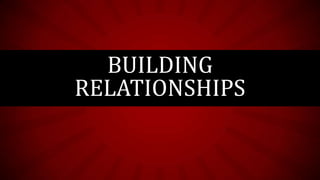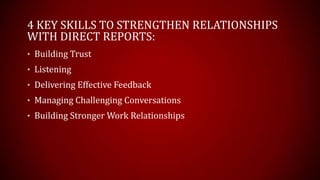Building relationships
- 2. BUILDING RELATIONSHIPS WITHâĶ âĒ Direct Reports âĒ Upwards âĒ Customers and Suppliers âĒ Across the Organization with Peers
- 3. BUILDING RELATIONSHIPS WITH DIRECT REPORTS
- 4. 4 KEY SKILLS TO STRENGTHEN RELATIONSHIPS WITH DIRECT REPORTS: âĒ Building Trust âĒ Listening âĒ Delivering Effective Feedback âĒ Managing Challenging Conversations âĒ Building Stronger Work Relationships
- 5. SOME COMMON MISTAKES IN BUILDING RELATIONSHIP AT WORK: âĒ Taking before giving. âĒ Being an opportunistic relationship builder. âĒ Seeing relationship building as playing office politics. âĒ Forgetting about results. âĒ Limiting your relationship circle.
- 6. âĒ It helps if manager and direct report can make a mutual choice when entering into their formal relationship. âĒ General manager should provide challenging tasks, set high standards, and enforce accountability. âĒ General manager needs to show an interest in the personal and professional development of subordinates.
- 8. Key distinction between middle level managers and CEOâs
- 9. MIDDLE LEVEL MANAGERâS (DIVISION MANAGER) âĒ Always concerned with line superiors âĒ Corporate staff groups
- 10. CEOâS âĒ Have their board of directors âĒ Major stockholders âĒ regulators
- 11. ASPECTS OF HOW DIVISION MANAGERS RELATE TO THEIR VARIOUS SUPERIORS ARE ALWAYS IMPORTANT ASSETS., ESPECIALLY IMPORTANT ARE: âĒ An ability to persuade higher level managers to endorse division proposals for resources to support research, new products, capital pro- grams, shift in strategy or organization
- 12. âĒ An ability to secure from superiors rewards and other signs of recognition for achievements âĒA protÃĐgÃĐ-mentor relationship coaching and other support the divisionâs that provides
- 13. HOW TO BUILD BUSINESS RELATIONSHIP
- 14. âĒ Listen More Than You Talk âĒ Make A Routine âĒ Be Honest âĒ Take Notes âĒ Give More than You Receive âĒ Be Proactive âĒ Be Real âĒ Turn Blunders into Opportunities âĒ Make it Personal âĒ Meet Face-to-Face
- 15. BUILDING RELATIONS WITH CUSTOMERS AND SUPPLIERS
- 16. PARTNERSHIPS âĒ People are key. â Build and develop relationships. âĒ Relationships between customer and supplier need to be collaborative, not necessarily contractual: â Open; trust; win-win; communication.
- 17. âĒ Customers and suppliers should be treated as partners in the activity: â Focused on outcome; some contact with target customers; shared responsibility. âĒ Fit with the organisational culture: â Level of formality; sponsorship from senior management; style.
- 18. THE LAPSES AND DIVERSIONS ON THE PART OF THE SUPPLIERS THAT CAN AFFECT THE RELATIONSHIP: âĒ Satisfaction: The customer expects overall attention and convenience in all departments to ensure smooth fulfillment of his needs. This includes quality, timeliness, ease of access and commitment of conditions. âĒ Competitiveness: Customers assess the supplier through competition based on the pricing and quality of their products, its reliability, its technological background and industry trends.
- 19. âĒ Innovation: Customer knows and lives the products more than the supplier does, as he is working on them and is in a position to suggest innovation and development for the products. âĒ Finance: Suppliers have to be ready for providing financial advantages as loan, extended terms on purchases and postponement of debt when demanded by their loyal customers particularly at their growth stage or when they are into a financial crisis.
- 20. Essential factors for the customers to create and maintain a healthy relationship with the suppliers. âĒ Payments always on time âĒ Provide adequate flexibility âĒ Personalize the relationship âĒ Share information âĒ Be a demanding but a valued customer
- 21. BUILDING RELATIONSHIPS ACROSS THE ORGANIZATION WITH PEERS
- 22. STRATEGIC RELATIONSHIP FORMS: âĒ Forming basic research relationships with other companies, focused on new materials and manufacturing methods âĒ Developing new sales channels in foreign markets âĒ Developing joint ventures to develop new markets
- 23. âĒ Many large companies have found it necessary and desirable to provide quality-related training to consultation to their suppliers-especially small suppliers who do not have their own training staff âĒ Many companies have formed industry consortia to fund research and development activities that they cannot afford to do alone âĒ Other companies have formed university-based consortia to fund research into future management, information technology, engineering, or manufacturing technologies and practices
- 25. In many ways, the old world was simpler: âĒ Telling direct reports what to do is a lot simpler than developing relationships with partners âĒ Being able to work in a âsiloâ is a lot simpler than having to build relationship with peers across the organization âĒ Selling a product to customer is a lot simpler than providing an integrated solution
- 26. âĒ Getting the lowest price from suppliers is a lot simpler than understanding their complex business needs âĒ Competing with customers is a lot simpler than having to develop a complex customer-supplier-competitor relationship
- 28. `


































